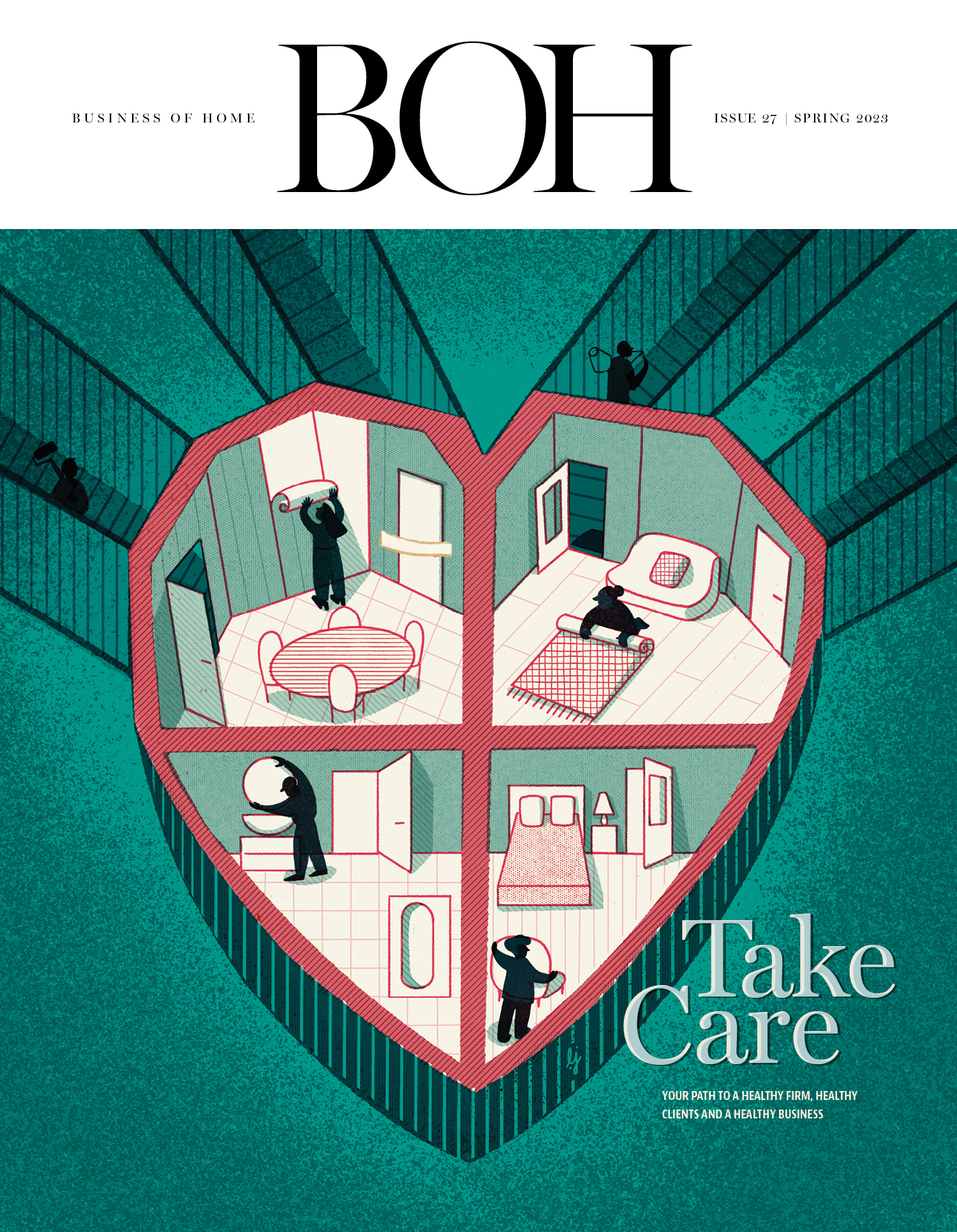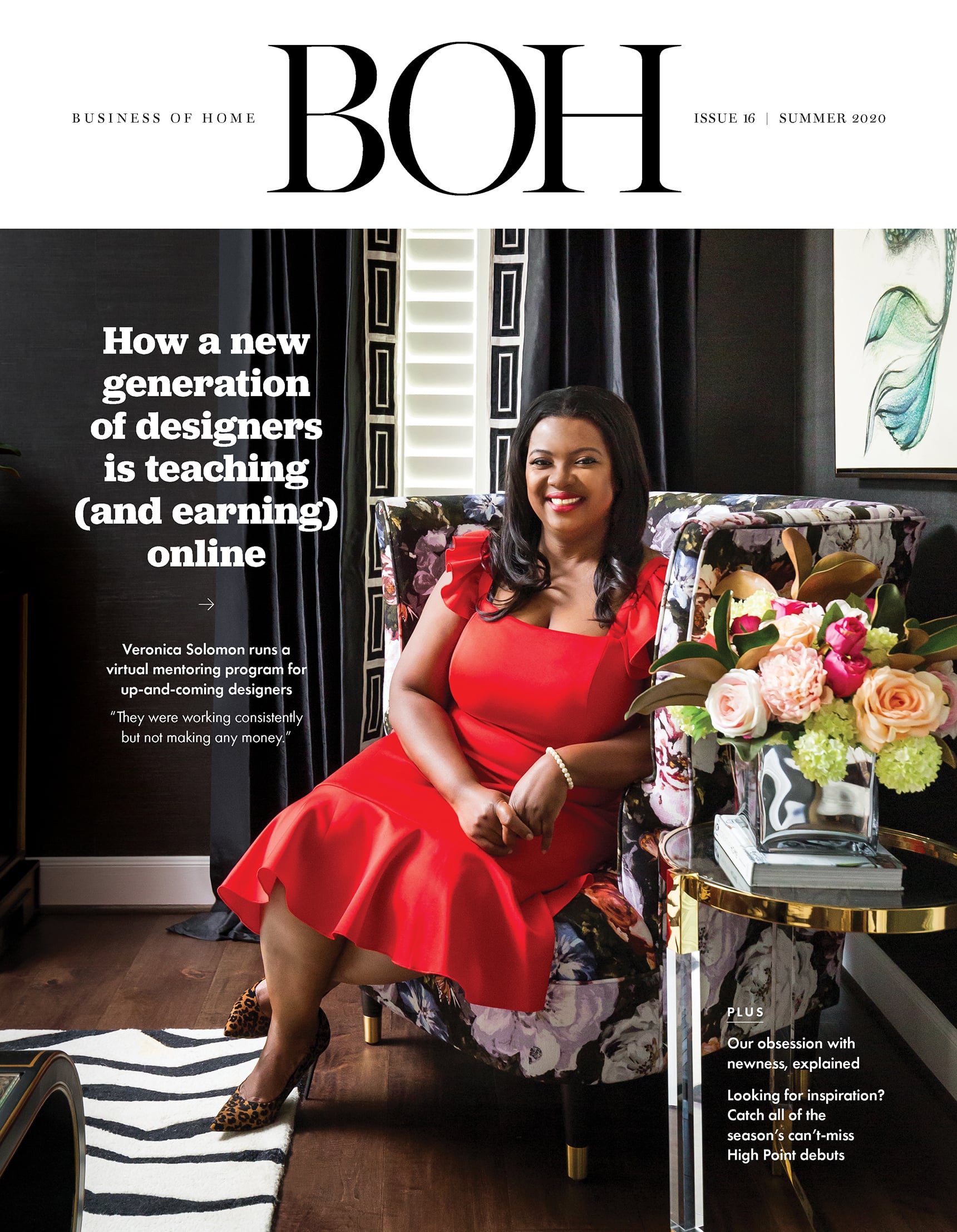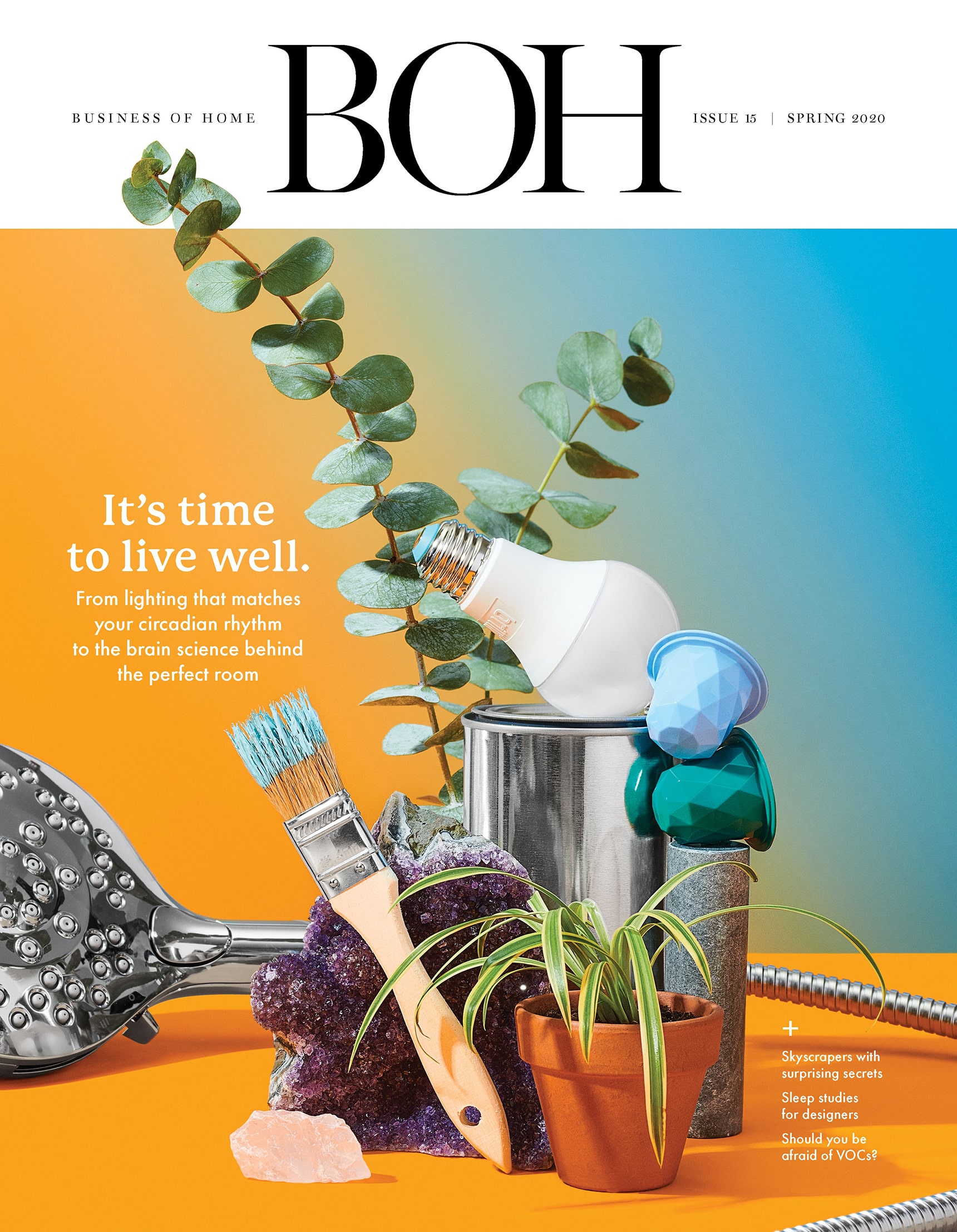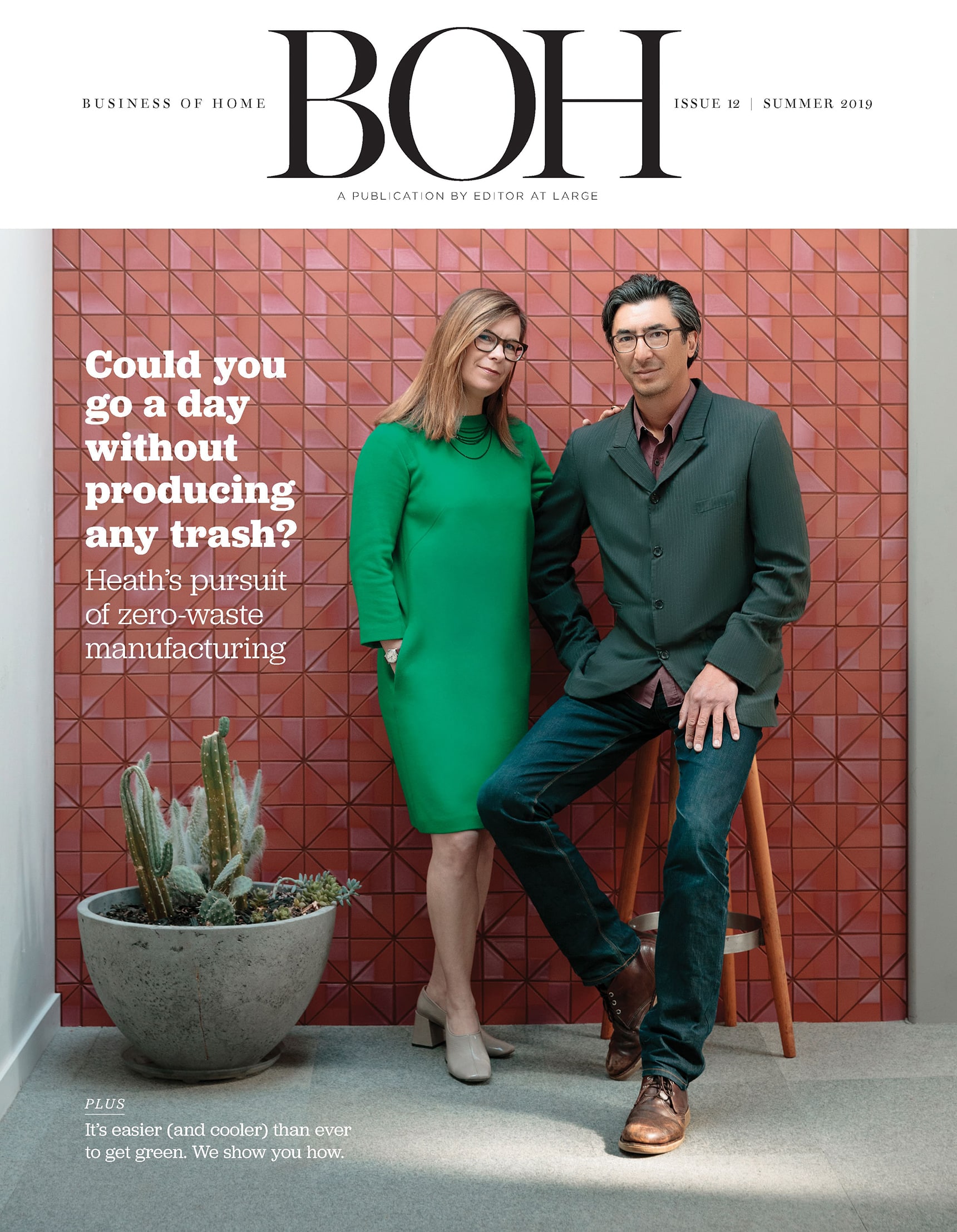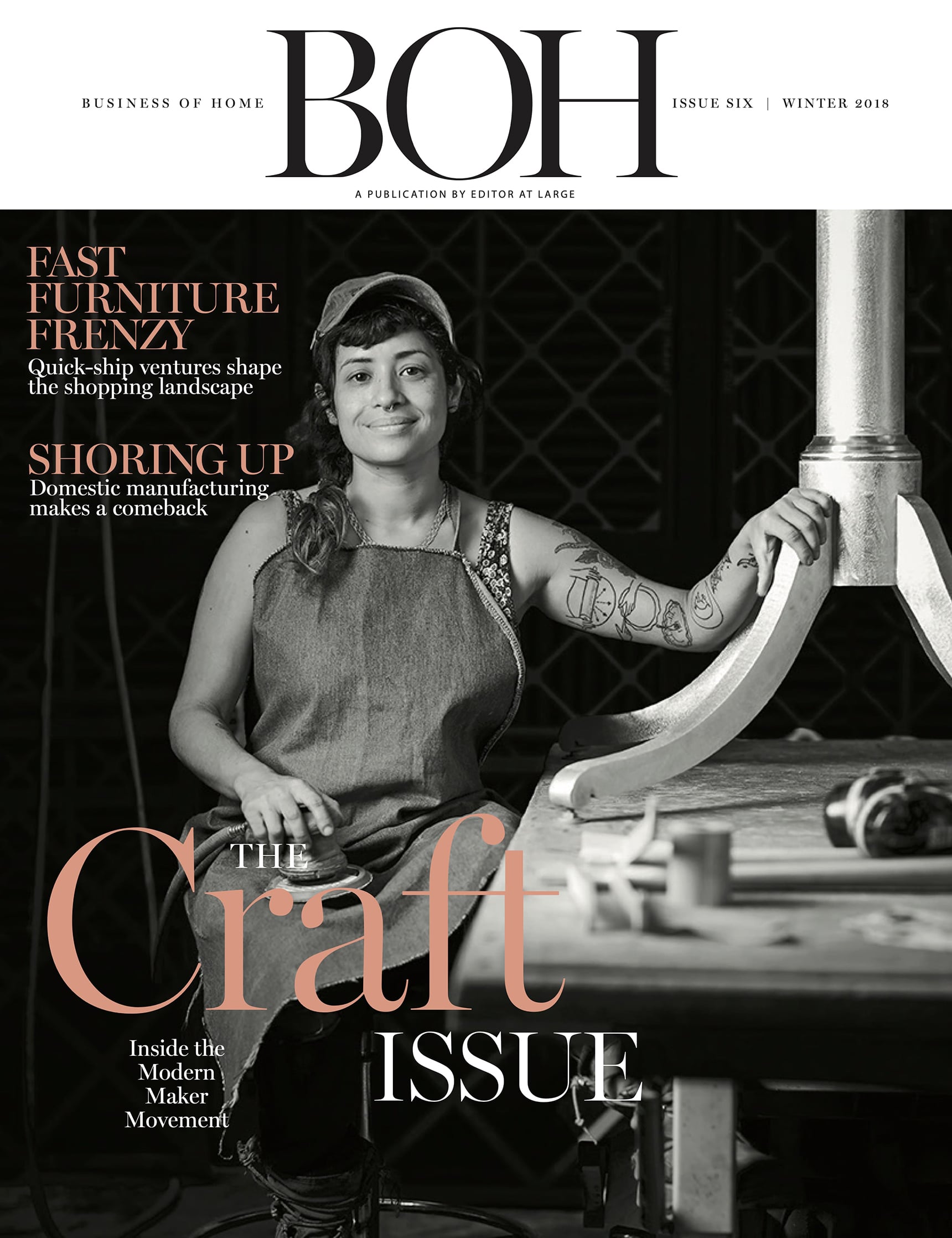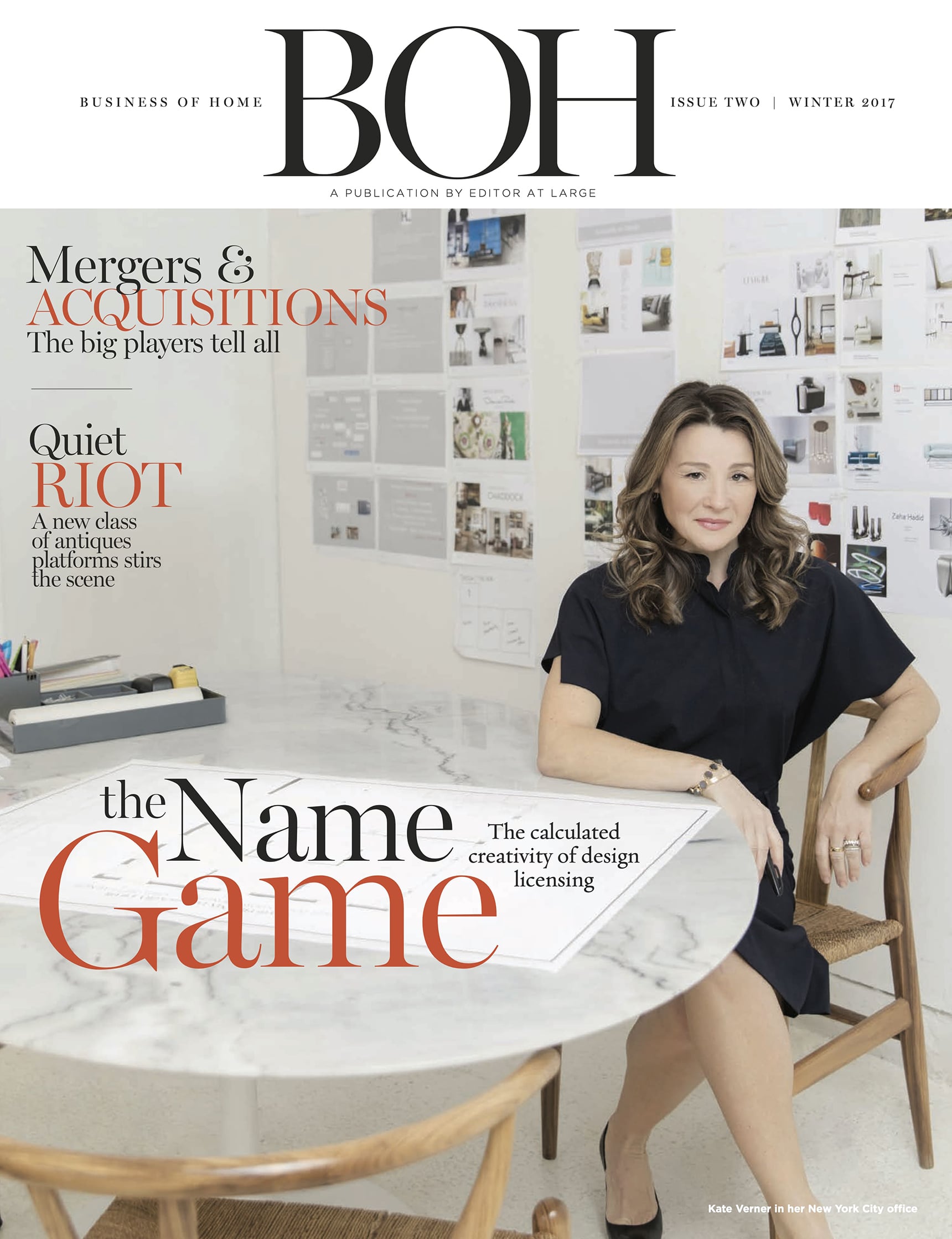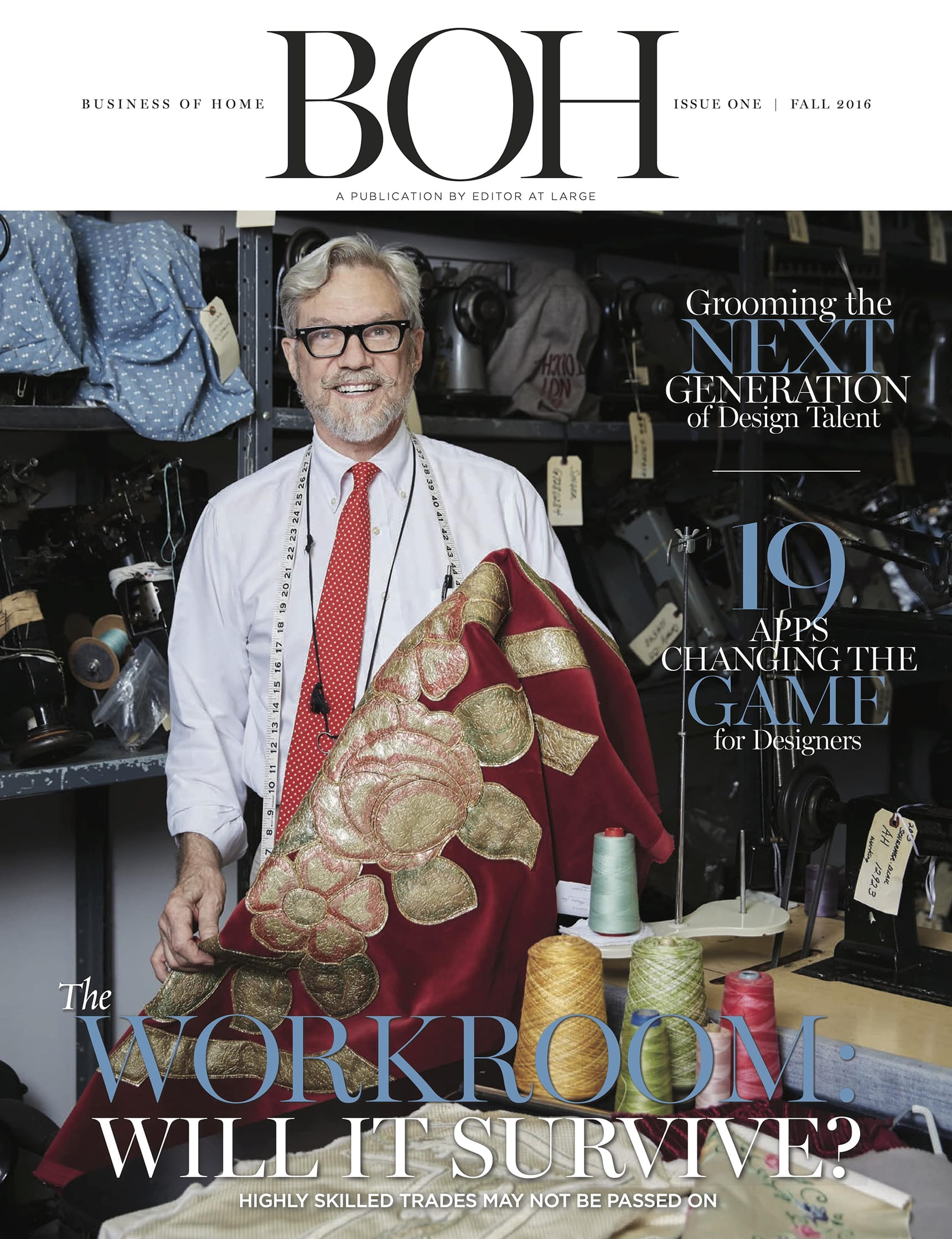By leveraging the latest research and technology, designers can create healthier spaces for clients.
We’re at a unique inflection point in our cultural attitudes toward health. With our surgical masks cast aside and the worst of the pandemic behind us (knock on wood), we’re ready for a new, healthier chapter—yet we’re also more aware than ever of the things that can make us sick. For people seeking homes that can enhance their health, or at least not hinder it, a growing body of research and a wave of new technologies offer strategies and solutions to do just that. As professionals on a mission to create beautiful environments that soothe clients’ souls and replenish their spirits, interior designers can go the extra mile by creating homes that are healthy too.
“I’ve had so many clients with a beautifully designed home tell me, ‘I don’t feel good,’” says Caroline Blazovsky, the New Jersey–based founder of My Healthy Home, a company that specializes in creating healthy living environments. “Often it’s the nicely designed house that’s toxic because the client brought in brand-new furnishings, textiles, building materials and products without addressing the air quality or other contaminants that pose a health risk. That’s part of the reason designers need to become more educated in the health side of home design.”
Don’t worry—it’s not all doom, gloom and dire warnings about toxic materials and hazardous furnishings. There’s also good news to be found in the current body of knowledge on how the home impacts health, and for every smart home device that tells you how a home isn’t healthy, there’s a matching tech-forward solution or holistic product option on the market. Not every good-for-you home feature has to be complicated, either. You might be surprised (and relieved) by how straightforward many home health solutions can be.
Tempted to leave this stuff up to the HVAC installer or general contractor? The truth is, even if your eyes glaze over at the mention of air quality or antimicrobial agents, knowing how to design a healthy home will play to your professional advantage in an increasingly health-conscious world. Think of this as your primer.
LAYING THE FOUNDATION
To simplify the process of seeing the home through the lens of health, Blazovsky has developed a three-part framework: “When you’re building a house or designing a space, you need three things to make it healthy— education of the occupants, building science and technology,” she says. “If you have two of those areas covered but forget the third, you’re making mistakes that will cost you health-wise.”
For clients, a lack of insider knowledge combined with the litany of other project parameters—budget, aesthetics and timeline, to name a few—may limit their ability to advocate for a healthy home. That gives designers a crucial role to play in the education component of healthy home-building. If you make it a priority from the start, and explain how your recommendations are tied to health outcomes throughout the design process, the client is far likelier to end up with a healthier space. Next in the trifecta is building science, a wide-ranging discipline that views the home as a system with different components such as energy efficiency, durability, comfort and air quality. While interior designer’s don’t need to become bona fide HVAC experts, a comprehensive understanding of how the different parts of the home interact and impact residents can help you make better recommendations to your clients. This is also where an understanding of clients’ unique needs comes in: You may have to sacrifice one design component in the name of another, more important, one—for example, prioritizing good ventilation over a tightly sealed, energy-efficient building—and your intimate knowledge of their values and preferences should guide those decisions.
Technology is the third and final piece of the healthy home puzzle and can be used in two ways to create a healthier home—to gather data and to improve conditions. “It’s very important to invest in a sensor system that gives environmental readings on indoor air quality, including relative humidity and the presence of volatile organic compounds, or VOCs,” says Blazovsky. “Whether it’s a wall-mounted carbon monoxide monitor or a handheld device, these tools tell you what’s happening in real time so you can adjust and make changes, through tech solutions, healthier products or lifestyle changes.”

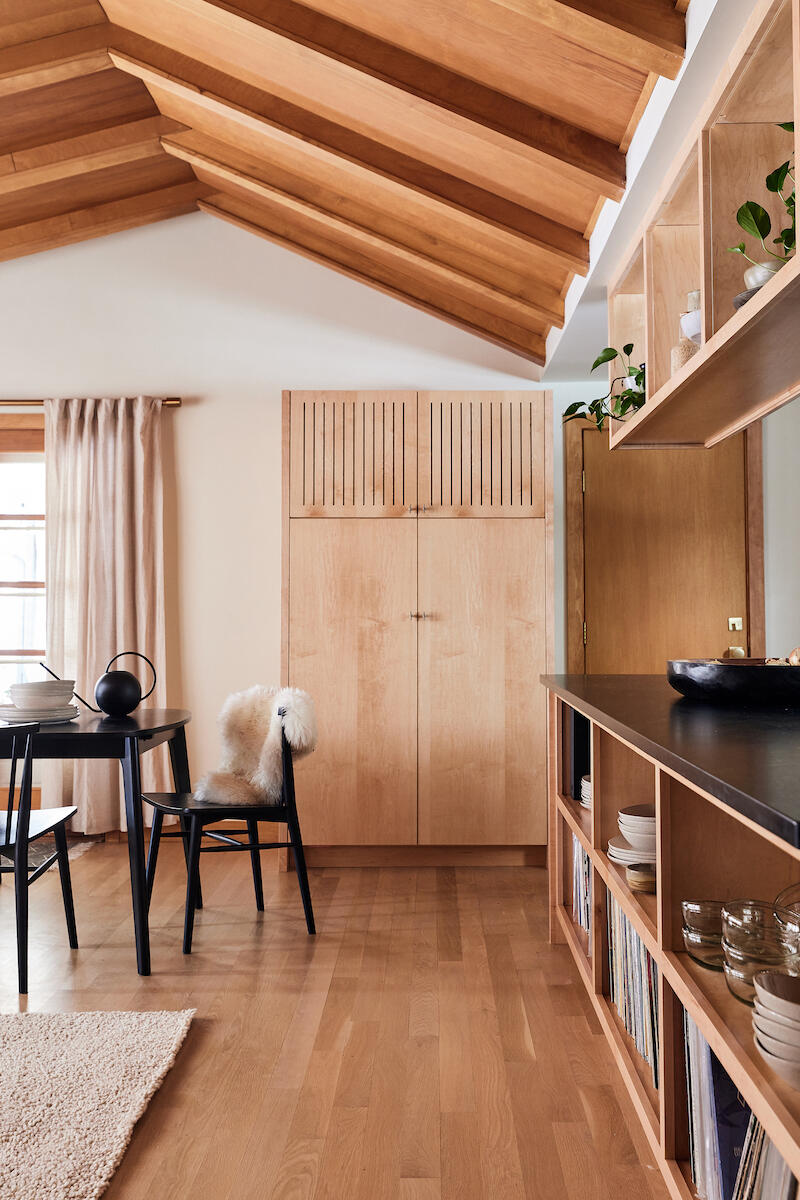
BREATHE EASY
Experts agree that air quality is the most important component of a healthy home— something consumers, manufacturers and regulatory bodies are increasingly paying attention to, as evidenced by rising concern over indoor air hazards such as gas stoves. “We have been forced to get an education since the pandemic,” says Blazovsky. “Four years ago, no one knew what a HEPA [high-efficiency particulate air] filter was; now everyone does. More people are aware of how things like viruses, bacteria and chemicals can be transmitted through the air. We have a baseline now, but it’s important to continue that education.”
The most-studied indoor air pollutants are particulate matter, nitrogen dioxide and VOCs, all of which are associated with a host of breathing issues, according to a 2020 study published in the International Journal of Environmental Research and Public Health. Inhaling particulate matter—which consists of solid or liquid particles from cooking, cleaning, pets and everyday activity—can have negative effects on both the lungs and heart. Breathing air with a high concentration of nitrogen dioxide—a gas that comes from unvented gas heaters, cooktops and stoves—can contribute to respiratory symptoms like asthma. Meanwhile, VOCs are released (or “off-gassed”) from thousands of household products and furnishings, and can cause all kinds of health problems, from allergies and cancer to liver and nervous system damage. The scariest part? According to the Environmental Protection Agency, VOC levels are up to 10 times higher indoors than outdoors.
A good place to start tackling indoor air quality is by understanding what kind of HVAC system a home has, since that’s going to help filter out particulate matter (but not gasses). “Most clients don’t know what kind of filtration system they’re dealing with,” says Blazovsky. “When people bring pollution into the house in the form of dander, skin cells and mites, the HVAC cleans the air and improves the environment. I call it the heart and lungs of a building—if it’s not working properly, it’s going to create other problems within the home.”
The majority of American homes today have forced-air systems, which means they run on electricity or a heat pump and blow conditioned air into the home via vents or splits. (Homes without central air are typically older and use steam or baseboard hot water systems, which don’t impact air quality as much.) For homes with forced air, designers should survey the locations of vents and conceptualize floor plans and furniture placement to avoid obstructing air flow. “Don’t block a supply vent with a sofa, or you could prevent clean, conditioned air from flowing into the room,” says Blazovsky. “Don’t keep things like litter boxes or dog beds near a return vent, or you’re going to circulate contaminants into the air.”
If fighting a laundry list of invisible toxins feels intimidating, fear not. There’s plenty you can do to help your clients breathe cleaner air in their homes. Advise that they invest in the highest-grade filter possible for their HVAC system, and seek out products for the home’s air handler or ductwork that offer mold or virus protection, like a UV light or hydroxyl system that provides an extra layer of filtration. And once they’ve got the right product, it’s important to clean and change the filter regularly based on home size and number of residents. Stand-alone air filter units are also an effective add-on measure, especially for highly trafficked spaces like living rooms. They’re especially worth considering for clients with asthma, allergies, big families or lots of pets.
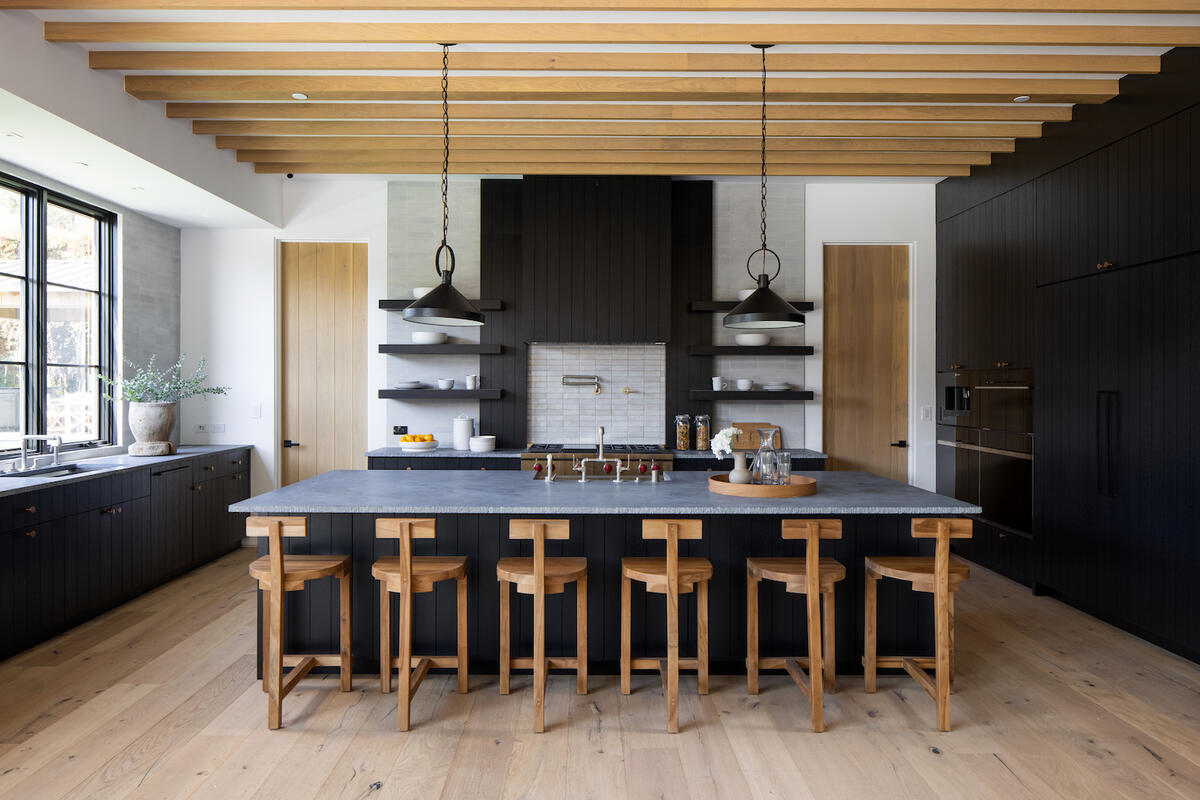
MATERIAL MATTERS
While top-notch air filters are crucial to a healthy home, another key step is to avoid contaminating the air in the first place. One significant aspect of healthy design that’s often overlooked is how the finishes and furnishings we bring into a home impact air quality. “Items like beds, sofas and carpeting act as sinks for contaminants, meaning they allow particulate matter to accumulate,” says Dak Kopec, an architectural psychologist and professor at University of Nevada, Las Vegas’s School of Architecture. Of course, beautiful fabrics and upholstery are integral to creating a warm, inviting home, but porous textiles absorb and retain far more particles than smoother, more impermeable surfaces. When designing for clients with respiratory issues, autoimmune conditions or other health vulnerabilities, you may want to limit fabric-based upholstery, suggests Kopec, and instead consider nonporous materials such as leather or leather-like alternatives. The same goes for floors: Rather than wall-to-wall carpeting, consider strategically placed throw rugs that can be removed for cleaning. However, even after opting for the most cleanable or least absorbent option, it’s still good to be mindful of particle buildup. According to Blazovsky, rugs should be replaced every five to 10 years due to the amount of particles and germs they accumulate that even through cleaning won’t necessarily extend that lifespan. While it might clean rugs visibly, it can actually bring more toxins into your home via cleaning chemicals. Opt for green dry cleaners whenever possible, and always leave just-cleaned items outdoors to air out before reinstalling them in a home.
In general, having a dash of skepticism as a consumer can pay off when it comes to creating a healthy home. “You have to be vigilant,” says Blazovsky. “Just because something is green doesn’t mean it’s healthy. Anytime you bring a new product into your house, it’s going to produce some kind of VOC.” That new-house smell you pick up on when you stroll through a freshly completed project is the direct result of chemicals being released into the air, not only from paint but also cabinetry, wood stains and furnishings, among other objects. Even low- or no-VOC paints still release compounds, just fewer than the synthetic alternatives. Finishes, too, are healthier when they’re all-natural and water-based, rather than oil-based, but they still emit compounds into the air. Essential oils and organic candles are considered air pollutants too, albeit minor ones. “The body doesn’t know if it’s inhaling synthetic or natural substances,” adds Blazovsky. “In either form, at high concentration, it’s not good for you.”
Given that off-gassing is inevitable with any new products, vintage or recycled furnishings are often the healthiest choice in order to minimize VOCs—especially hard furnishings like tables and case goods, where you don’t have to worry about fabrics or upholstery that have have picked up years’ worth of dirt. If a client has health concerns or lives with a vulnerable family member like a baby or older person, educate them about the health risks of synthetic materials and new furnishings, and offer alternatives, like organic fabrics (wool, cotton or linen) or products that are Greenguard Gold certified (a low-VOC emission certification issued by science safety company Underwriters Laboratories). Frequent maintenance can also be the answer, as long as clients understand that they’ll have to clean the spaces where they choose to install more porous furnishings like curtains, wallpapers, upholstered pieces and rugs more often.
LIGHTING CUES
Just as important to health—and likely more fun for designers than air filters—is to nail the lighting in a home. Although some studies have sought to uncover the health effects of different colors or sources of light, it turns out that timing and quantity of exposure are the two most important factors for regulating our circadian rhythms, says Jennifer Brons, research program director of the Light and Health Research Center at the Icahn School of Medicine at Mount Sinai.
“To promote overall long-term health, you want exposure to bright light in the morning and dim light in the evening,” says Brons, noting that her team has connected such exposure with improved sleep and better mood. “The best, most impactful thing you can do is to tell your body that earlier in the day it’s time to be awake and alert and do things like digest food and create new blood cells; whereas at night, dim light helps you [wind down] and heal.”
The source of the light can be either natural or electric, and if it’s natural, Brons suggests design techniques that will diffuse sunlight in high-activity rooms where you’re working, watching TV or cooking. For a client who works from home, that could mean positioning a desk so that it’s exposed to windows but does not receive direct light, or, in a room with fewer windows, ensuring there’s ample bright electric lighting to regulate the body’s natural rhythms. Any sort of electric lighting will do, she adds. If you’ve heard rumblings about the dangers of LEDs, don’t worry—that theory has been debunked.
Although Brons says timing and amount of light trumps color when it comes to regulating your body’s rhythms, she sings the praises of soft, warm lighting—something interior designers will likely be relieved to hear. “In the home, you want an inviting ambiance,” she says. “That’s much better than sterile, institutional light.” Another suggestion: Get more creative about lighting design. “I’d like to see more layers of light hiding in architecture, tucked up into spaces, making surfaces glow without showing bare bulbs,” says Brons. “Not only is that helpful for vision, it also makes materials in the home look good.”
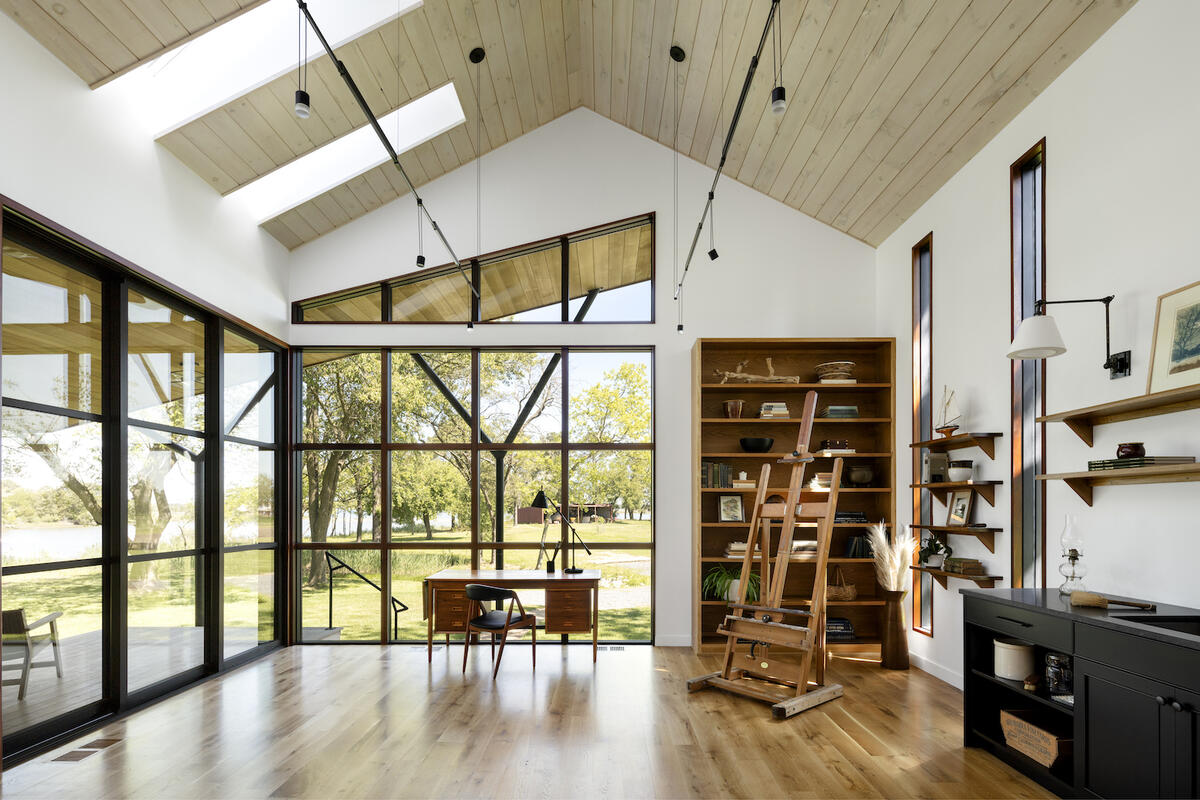
REST RIGHT
Some aspects of healthy bedroom design are fairly well established: Use blackout window treatments and a high-quality mattress to enhance sleep; choose lighting thoughtfully to complement circadian rhythms; and opt for serene, soothing color schemes and layouts that minimize stress and clutter. Those principles all still hold true when it comes to creating a room that facilitates rest, relaxation and rejuvenation.
Recent research shows that ventilation is a critical component of healthy bedroom design, and circulating indoor air at night (versus bringing in air from the outside) may be most effective in improving inhabitants’ sleep quality. According to a 2021 study by researchers at Shanghai Jiao Tong University in China, the simple act of opening the bedroom door and allowing air to move between rooms improved sleep quality more than opening windows—this was particularly true during spring, fall and winter, and during early-morning hours. The study also found that leaving bedroom doors open for at least 15 minutes during the day helped participants catch more Z’s. For designers, being mindful of bedroom layouts that give sleeping occupants privacy even when the door is open (with a stylish doorstop or a room-diving screen, perhaps) is one strategy to explore.
Another way to improve sleep through air quality, according to that same study, is to avoid placing plants in the bedroom. Among the 1,130 study participants—Shanghai residents who reported on their bedroom conditions and sleep quality over the course of a year—those who slept in plant-free spaces experienced a whopping 74.5 percent chance of sleeping better than those with greenery nearby. That’s because of the carbon dioxide released by many plants in the process of respiration—especially sizable, scented or flowered species.
“Generally speaking, large, leafy plants produce a lot of carbon dioxide at night,” says Xinbo Xu, a Ph.D. candidate at Shanghai Jiao Tong University’s Department of Architecture and co-author of the study. While it’s true that plants also purify the air through photosynthesis, that may not necessarily counteract the air pollution they create in a space like the bedroom, explains Xu—especially if it’s a smaller room. So find that monstera plant a new home outside your client’s bedroom.
KITCHEN CURES
Designing a healthy kitchen is largely about ensuring safety in a highly trafficked, food-oriented space. It’s the room where proper ventilation matters most, because without that, “you could be taking years off your life,” says Blazovsky. “If you cook without a vent fan, you’re in big trouble because you’re basically [creating the same level of pollution as] a major metropolitan city.” A hooded vent over the cooktop that funnels contaminated air outside is a must—and while that might seem obvious, it’s not legally required in every state, so if you’re working with clients on a budget, make sure they understand the importance of this feature. (And once it’s installed, encourage clients to use it whenever they cook, or opt for a product with flame or temperature sensors that automatically turn on the fan and adjust its speed as necessary.) As you’re finessing floorplans, the kitchen is also a great place to add extra circulation through design details like sliding deck doors and large windows that can help air out the space more thoroughly.
It’s not all about air, either. As a space where people cook, eat and gather, the kitchen is also a wise place to invest in smart home features that will help keep things looking sleek and functioning optimally. Touchless faucets are a great option to prevent the transfer of germs as well as buildup of gunk. Testing tap water for harmful toxins is also a wise idea. You can apply filters that help address problems like chemicals and chlorine (common with city water), but first you must use a sensor system or hire a testing company to find out what’s actually in your water. “Every house and water supply is different,” says Blazovsky. “You won’t get a generalized system that covers everything, so you need to know if there’s a problem in order to fix it.”
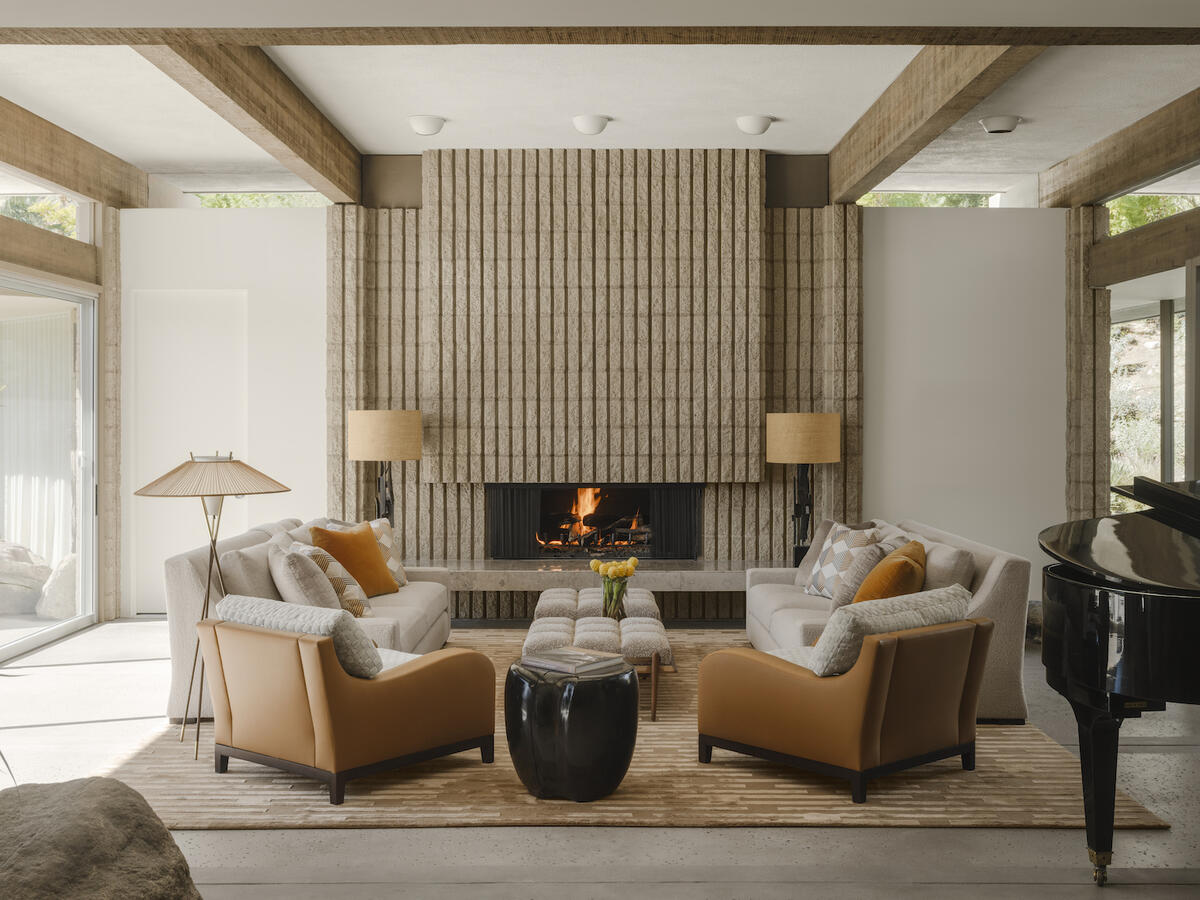
BATHROOM BASICS
Another room that requires high functionality and not just good looks, the bathroom is a space that’s ripe for smart technology. Beyond touchless faucets, other cutting-edge options to explore include watertight shower systems and high-tech toilets. The former involves laying a waterproof foundation under a shower or bathtub to prevent mold, mildew and leaks. This allows you to use the gorgeous tile your client loves without the health risks that can come with such a porous and water-absorbent material. Many of today’s systems come with 20-year guarantees, which means your client won’t have to worry about springing a leak for the long haul.
As for the porcelain throne, the toilets being manufactured today come with a number of healthy add-ons, from UV technology to antimicrobial agents and slip technology (a veneer that conserves water and cuts down on germs). Blazovsky points out that the “tornadic activity” that happens during flushing propels a swirl of airborne bacteria, so any of those tech features will be welcome—though you can also simply advise clients to modify their behavior or pick a toilet with an auto-closing lid.
FRESH START
As useful as it can be to learn about how to make your clients’ homes healthier, it can also feel daunting. Knowledge is power, but may risk leading to neurosis as you discover all the invisible ways the stuff in our homes can mess with our health. While designers certainly aren’t expected to become healthy-home Ph.D.s, you are a trusted authority on the home, and the more you know, the better you can serve your clients.
“The home is our biggest asset, the biggest investment we make,” says Blazovsky. “So many people wake up every day feeling stuffy or with headaches, but they shouldn’t. Your home should be your oasis, where you’re safest—where you have good air quality and good light; the place where you do right by your body.”
Your clients hire you to turn their home into a personalized sanctuary. That usually means window treatments and wallpaper, not air filters and smart toilets. But making the effort to learn about how to design a healthier space will mean your clients won’t just love how their home looks—they’ll love how they feel inside it.
Homepage image: Designer Gala Magriña created an urban sanctuary in a New York high-rise with a neutral palette, organic textures and natural materials | Joseph Kramm





